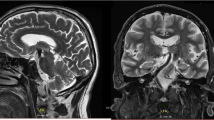Summary
The diagnosis of occlusion of the intradural vertebrobasilar artery (OIDVBA) was made by means of cerebral angiography in 22 patients. The clinical presentation, course and followup were studied in conjunction with the angiographic findings in each case and the following conclusions made. OIDVBA is not rare. It occurs one-fourth as often as occlusion of the carotid artery. The correct diagnosis is not made clinically before angiography in the majority of patients. Complete visualization of the neck and intracranial vasculature is necessary to document the occlusion. Atherosclerotic thrombosis is the most common type of occlusive lesion. The most common predisposing factors are atherosclerosis, hypertensive cardiovascular disease, diabetes mellitus, and developmental vertebrobasilar hypoplasia. Most patients with occlusion are in the 7th and 8th decades of life and transient attacks of vertebrobasilar ischemia precede the occlusion in one-half of the cases. Emboli usually lodge in the terminal portion of the basilar artery whereas thrombotic occlusions tend not to be located in a characteristic segment. A majority of patients diagnosed angiographically survive their OIDVBA, but most distal occlusions result in death, often following several weeks of coma. In the surviving majority, disturbance of gait, impairment of vision, and symptoms of transient vertebrobasilar ischemia are the most common sequelae.
Similar content being viewed by others
References
Schott, B., Michel, D., Goutelle, A.: Sténoses et thromboses carotidiennes á expression vertébro-basilaire. Hémodétournement basilo carotidien. Rev. neurol. 121, 501–514 (1969)
Moscow, N.P., Newton, T.H.: Angiographic implcations in diagnosis and prognosis of basilar artery occlusion. Amer. J. Roentgenol. 119, 597–604 (1973)
Gomensoro, J.B., Maslenikov, V., de Pérez, G.L., Botinelli, M.D., Tenyi, A., Azambuja, N., De Boni, J.A., Abo, J.C.: Pathology of the vertebrobasilar system. Acta neurol. lat.amer. 15, 180–189 (1969)
Utkin, V.V., Stepanova, E.A.: The clinical picture and diagnosis of thrombosis of the basilar artery. Zh. Nevropatol. Psichiatr. 71, 26–31 (1971)
Bradshaw, P., McQuaid, P.: The syndrome of vertebro-basilar insufficiency. Quart. J. Med. 32, 279 (1963)
Kubik, C.S., Adams, R.D.: Occlusion of basilar artery: clinical and pathological study. Brain 69, 6–121 (1946)
Ouvrier, R.A., Hopkins, I.J.: Occlusive disease of the vertebrobasilar arterial system in childhood. Develop. Med. Child Neurol. 12, 186–192 (1970)
Pochaczevsky, R., Uygur, Z., Berman, A.J.: Basilar artery occlusion. J. Canad. Ass. Radiol. 22, 261–263 (1971)
Sloop, R.D., Lium, J.H.: Systemic arterial embolism arising from pulmonary thrombophlebitis. Amer. Surg. 37, 503–505 (1971)
Gaan, D., Mallick, N.P., Brewis, R.A.L., Seedat, Y.K.: Cerebral damage from declotting Scribner shunts. Lancet 1969 II, 77–79
Latchaw, R.E., Seeger, J.F., and Gabrielsen, T.O.: Vertebrobasilar arterial occlusions in children. Neuroradiology 8, 141–147 (1974)
Loop, J.W., White, L.E., Jr., Shaw, C.M.: Traumatic occlusion of basilar artery within clivus fracture. Radiology 83, 36–40 (1964)
Lorenz, R., Vogelsang, H.G.: Thrombose der Arteria basilaris nach chiropraktischen Manipulationen an der Halswirbelsäule. med. Wschr. 97, 36–43 (1972)
Harwood-Nash, D.C., McDonald, M.B., Argent, W.: Cerebral arterial disease in children; an angiographic study of 40 cases. Amer. J. Roentgenol. 111, 672–686 (1971)
Taveras, J.M.: Multiple progressive intracranial arterial occlusions: a syndrome of children and young adults. Amer. J. Roentgenol. 106, 235–269 (1969)
De Vivo, P.C., Farrell, F.W.: Vertebrobasilar occlusive disease in children. A recognizable clinical entity. Arch. Neurol. 26, 278–281 (1972)
Meyer, J.S., Sheehan, S., Bauer, R.B.: Arteriographic study of cerebrovascular disease in man. Amer. med. Ass. Arch. Neurol. 2, 27–45 (1960)
Brihaye, J., Retif, J., Jeanmart, L.: L'obstruction de l'artère basilare chez le sujet jeune. Aspects cliniques et angiographiques. Réflexions étio-pathogéniques. A propos de trois cas. Acta neurochir. (Wien) 24, 143–156 (1971)
Campiche, P.R., Anzil, A.P., Zander, E.: Anévrysme disséquant du tronc basilare. Schweiz. Arch. Neurol. Neurochir. Psychiat. 104, 209–223 (1969)
Fowler, M.: Two cases of basilar artery occlusion in childhood. Arch. Dis. Child. 37, 78–81 (1962)
Drake, C.G.: Further experience with surgical treatment of the basilar artery. J. Neurosurg. 29, 372–392 (1968)
Schechter, M.M., Zingesser, L.H.: The radiology of basilar thrombosis. Radiology 85, 23–32 (1965)
Author information
Authors and Affiliations
Rights and permissions
About this article
Cite this article
Thompson, J.R., Simmons, C.R., Hasso, A.N. et al. Occlusion of the intradural vertebrobasilar artery. Neuroradiology 14, 219–229 (1978). https://doi.org/10.1007/BF00418619
Received:
Issue Date:
DOI: https://doi.org/10.1007/BF00418619




